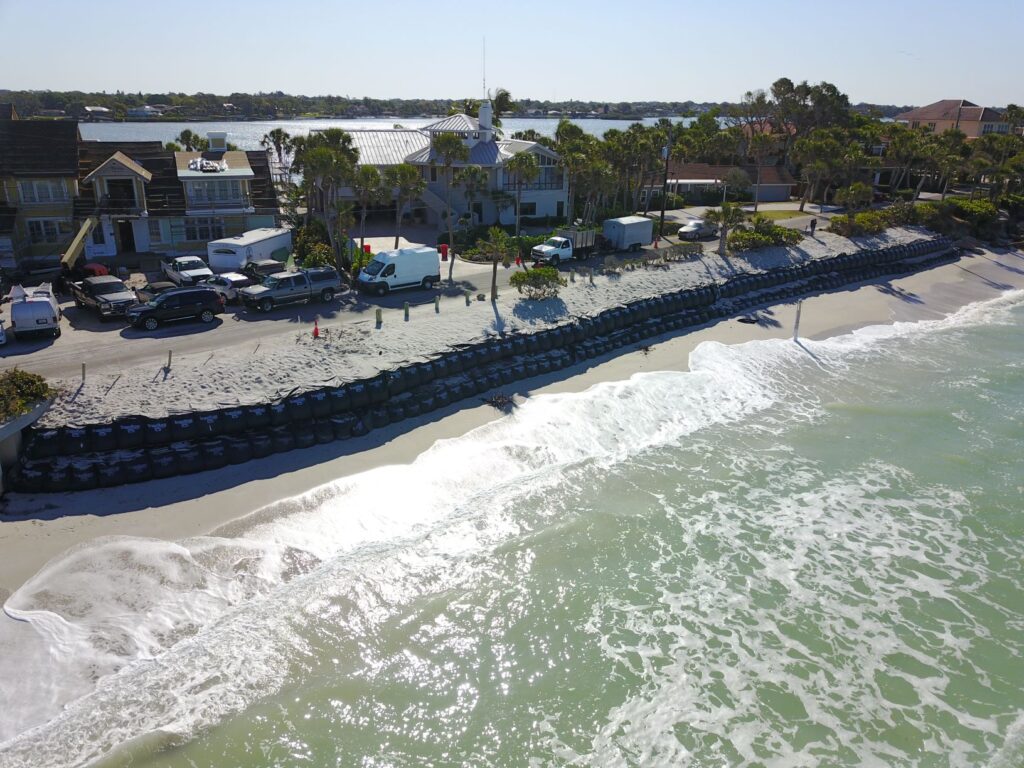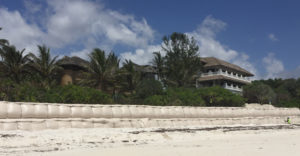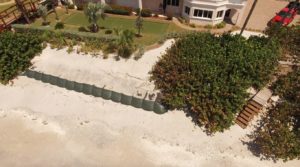Protect Banks & Shorelines with Soft Shoreline Stabilization
Find out how TrapBags can help you provide soft shoreline stabilization and protect banks. Erosion can be devastating, but we can help.

Prevent Erosion with Shoreline Stabilization
Some form of shoreline stabilization is necessary to prevent potentially devastating or hazardous erosion. Stabilization can allow for absorption of storm surges while maintaining the natural dynamics of the shoreline. Sand movement is inevitable, but steps can be taken to reduce our impact on beaches and protect them as well as the nearby beachfront properties.
If shoreline erosion continues untouched, it will inevitably result in less shores used for recreation which impacts the nearby communities and their tourism economy. On top of that, flooding will cause property damage as beaches grow smaller and dunes disappear. This lack of protection creates a chain reaction of destruction that can be prevented with early action.
TrapBag® offers solutions for soft shoreline stabilization. Filled with sand or other natural elements, these bags help create an anchor to slow erosion due to wind and water.
What Causes Coastal Erosion?
Coastal erosion is the result of many different factors. Working together, these factors can create chaos when unchecked.
- Climate change: Climate change has led to storms occurring more often and with an increased strength than those of the past. These storms create strong waves, winds, and floods that speed up the progression of erosion. At the same time, sea levels have been steadily rising, leading to even more sand movement and shoreline erosion.
- Natural water movement: It’s only natural that waves meet the shore and pull the sand back out into the sea. It’s our recreation that is not the way of nature. This means that the natural water movement that creates erosion affects us more quickly than it would affect the natural flora and fauna.
- Human presence: The presence of humans is also a major factor in shoreline erosion. The modifications we’ve created at dams and rivers has caused a reduction in the amount of migrating sediment from waterways. This means coastlines aren’t getting the deposits they need. We deepen channels for our own transportation use and focus on beaches as recreational areas leading to more construction and change. At the same time, human action can slow the process of erosion and create stability.
Effects of Coastal Erosion
There are various detrimental effects of coastal erosion.
- Loss of land: From cliff erosion on coastlines to beach erosion, land used for property and recreation is quickly disappearing. According to the U.S. Climate Resilience Toolkit, “the United States lost an area of wetlands larger than the state of Rhode Island between 1998 and 2009,” and many coastlines face losses as high as 25 to 50 feet per year.
- Harm to the ecosystem: As the shoreline erodes and dunes disappear, local ecosystems and habitats are destroyed. This negatively impacts wildlife as their homes are washed away.
- Decrease in property value: As the area tourism is affected by erosion, so then is the economy. Buyers are less likely to search for a beach house that could be destroyed at any moment by the impending flooding and erosion emergency. In turn, property value can drop immensely and affect the entire region.
- Reduction in tourism: As beaches shrink, drastic measures often have to be taken. Whether a beach is just small and crowded or has to close completely for the safety of the ecosystem and nearby properties, this greatly affects tourism. In turn, local economies are affected.
- Risk of injury: The increased risk of flooding and structural failures causes an increased risk of injury to nearby tourists and community members.
Who Needs Shoreline Stabilization?

The following groups can benefit from shoreline stabilization:
- Coastal engineers: The U.S. is home to more than 84,240 miles of coastline with 41% of it exposed to the open ocean. Coastal engineers are in charge of protecting the coast against changes by minimizing the detrimental impacts of both natural and man-made occurrences. Shoreline stabilization is directly related to their job.
- Waterfront hotels: Because shoreline erosion impacts tourism, it impacts the success of waterfront hotels. Less visitors to the beach means excess vacancy and loss of funds. This eventually leads to closures and abandoned beachfront properties.
- Coastal commercial businesses: No tourists means no business. For those businesses catering to locals, their property is at risk of damage from erosion and flooding.
- Coastal state parks: State parks that exist along coastlines are at risk of damage. Not only to the manmade structures and properties on site, but also to the natural ecosystems that exist within.
Hard vs. Soft Shoreline Stabilization
There are two main varieties of shoreline stabilization. Soft stabilization is a much better solution for the environment and more sustainable overall.
Hard Stabilization
Hard stabilization uses man-made structures as protection to control erosion. Usually, these structures are installed at right angles or parallel to stop sand movement and lessen the force of waves.
Most forms of hard stabilization like seawalls and sheet metal are not ideal for shoreline stabilization. They’re not appropriate for high-energy environments. There’s also not enough evidence of their effectiveness depending on the type of shoreline and local conditions. Hard stabilization techniques tend to be more difficult to install and don’t match the natural aesthetic, sticking out like a sore thumb and harming local ecosystems in many scenarios.
Soft Stabilization
 Beach nourishment is the process of adding lost sand and sediment back to beaches after erosion has occurred. The added sand, brought in from various external locations, widens the beach for tourists and locals and adds protection against waves. TrapBags aid in the process of beach nourishment by protecting natural ecosystems and allowing plants to grow. While this process can be costly and is not permanent, the pros tend to outweigh the cons.
Beach nourishment is the process of adding lost sand and sediment back to beaches after erosion has occurred. The added sand, brought in from various external locations, widens the beach for tourists and locals and adds protection against waves. TrapBags aid in the process of beach nourishment by protecting natural ecosystems and allowing plants to grow. While this process can be costly and is not permanent, the pros tend to outweigh the cons.
TrapBags as Natural Shoreline Protection
TrapBag barriers offer many properties that make them ideal for coastal and riverbank erosion protection. They’re:

- Extremely durable: TrapBags are made of high-strength textile, making them last longer than competitors. You’ll be able to utilize them for at least ten years. They are also patented with a support system and have a special coating that helps protect them against harmful UV rays and last even longer.
- Environmentally friendly: You can use native soil both to surround and to fill the TrapBags. You can also place natural vegetation around the bags, both preventing erosion and naturally protecting them. This ensures an environmentally friendly solution. This is an environmentally conscious way to solve stabilization issues. We recommend placing natural vegetation after installation to prevent further erosion and protect the bags even more.
- Less visually obtrusive: Instead of creating a distracting landscape full of sharp, square objects, try TrapBags. They blend in better with the environment and can even be customized. One client in Kenya even painted the bags to have them further blend into the landscape.
- Easy to install: Ease of installation means TrapBags can be deployed quickly in the event of an emergency. They can also be installed without any heavy machinery.
- Affordable: TrapBags are ideal for both small and large areas of shoreline. They provide an affordable solution to cover projects of any size.
Get Durable Erosion Prevention Today
Protect properties and beaches both in the short term and long term. TrapBags are your reliable solution for erosion prevention along coastal and river shorelines. Shop today and take advantage of advanced preparation.
Meet the author
Get the Dirt Before the Flood Hits
Stay ahead of flooding, erosion, and disaster response challenges. The Dirt, TrapBag’s monthly newsletter, delivers field-tested tips, real-world case studies, and the latest in barrier technology straight to your inbox.

